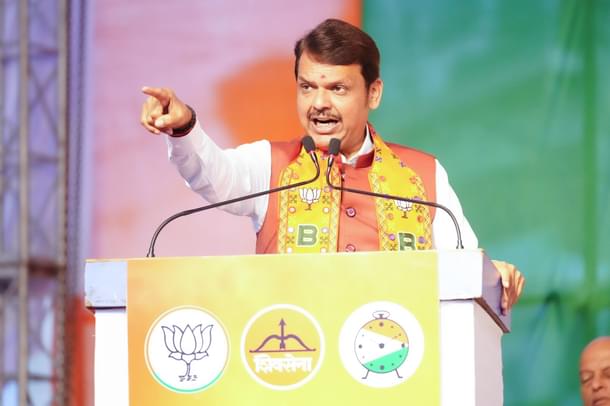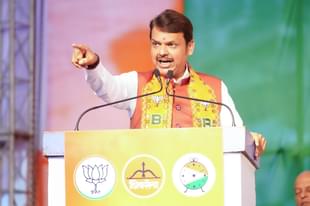Politics
Fadnavis 3.0: Implications For Maharashtra, BJP, And Challenges For Himself
Nishtha Anushree and Arush Tandon
Dec 05, 2024, 09:45 PM | Updated Dec 06, 2024, 06:07 PM IST
Save & read from anywhere!
Bookmark stories for easy access on any device or the Swarajya app.


Devendra Fadnavis is back as Maharashtra chief minister. The decision came after 11 days of suspense but a minute of quiet consideration would have made it plain that there was no other way this could have played out.
The mandate for the Bharatiya Janata Party (BJP) (and the Mahayuti) was simply too big and too clear to read any other interpretation into it. Had the BJP not crossed a 100 seats in the Assembly of 288 and was stuck somewhere in the 90s, Eknath Shinde had reason to be confident and push his case, which was entirely legitimate. Shinde broke away from Uddhav Thackeray in the name of Hindutva, the unofficial organising principle of the BJP; being a Maratha, he insulated Fadnavis and BJP from charges of running a ‘peshwai’, a euphemism for Brahmin rule. At the same time, he took care to not wear his caste identity on his sleeves so as to repel the communities seen as traditional BJP supporters.
However, with BJP alone at 132 seats—along with other candidates who won on allies’ symbols but are originally BJP members—the BJP by itself is almost touching the majority mark of 145.
The choice of Fadnavis wasn’t only determined by BJP’s numbers though. This was not about the BJP leadership (read Modi) selecting a leader from the party because it achieved historic numbers in the new Assembly. This was specifically about selecting Fadnavis.
Fadnavis had run a tight ship between 2014-19 and his administration delivered on both the policy and politics fronts. Caste is important in India, caste is important in Maharashtra but ultimately nothing is as important as the stability of the government. In the incoming government in Maharashtra, BJP would have two assertive but important allies, and 131 of its own MLAs, who would all be expecting to be accommodated in positions of power. Add to that Maharashtra’s own complexities—geographical, social, economic.
When the criterion of delivering a stable government in such a field of play is introduced, no other leader from Maharashtra BJP is left in the list of probables apart from Fadnavis.
Fadnavis, on his part, had done the penance for the ‘win-turned-loss’ and subsequent embarrassment of 2019. In the preparation of the Assembly elections five years back, there were charges of Fadnavis letting his ego have the final say in many decisions which initially curtailed his competition within the BJP but eventually ended up damaging the party itself. Outside the party, there was the issue of handling, or mishandling, the Shiv Sena and Uddhav Thackeray. Above all of this came the embarrassment when Ajit Pawar broke from Sharad Pawar and joined Fadnavis in a swearing-in held at dawn, only to return to his uncle a day later, leaving Fadnavis humiliated and alone.
The penance came in the form of serving as the leader of Opposition for 2.5 years before swallowing his pride and working as deputy chief minister for another 2.5. The latter is also the reason why Shinde could not have argued that the post of the deputy chief minister was a humiliation for him. He had Fadnavis’ example before him.
So Fadnavis is CM. What now?
Fadnavis has to show early wins for the responsibility entrusted to him. In the immediate term, decisions are needed to restore the euphoric narrative which had almost fallen flat after Eknath Shinde’s apparent dissent.
In the relatively longer period of first 4-6 months, he has to show wins to set the tone and demonstrate that it’s the same Fadnavis of the old. This is also important to pre-empt the narrative ‘machine’ in Maharashtra. A state as diverse and complex will always have challenges for the incumbent. Three or four big decisions in the so-called ‘honeymoon’ period will keep Fadnavis ahead of the narrative, if not in total control of it. Otherwise catching up with the ‘machine’ can occupy all of one’s time, apart from being draining.
On the political front, one specific objective in the short term can be eliminating the ability of the NCP(SP) to mobilise. That will bring to conclusion a project Fadnavis himself initiated in his first term as CM.
Long term challenges
Fadnavis’ stated goal is to take Maharashtra to $1 trillion GSDP. The same was repeated recently by an officer working closely with him who said that the government aims to double the GDP of Maharashtra by the end of this decade, from the current $500 billion to $1 trillion. What was unsaid because it’s assumed is that Maharashtra needs to attract industries towards it to achieve this target.
Today, however, the state faces greater competition from others than it did in the first tenure of Fadnavis. Karnataka and Tamil Nadu offer dynamism through developed and thriving manufacturing and software ecosystems, both. This combination is not absent in Maharashtra but Karnataka especially scores higher on this count.
On pure manufacturing—Gujarat has mastered the permissions and permits process and does it faster than any other state, including Maharashtra.
Even Haryana can now boast of enabling industries that will ultimately be fed by the largest urban conglomerate in the world, the NCR.
In this context, a clear and particularly tricky challenge for Fadnavis is to restore Maharashtra’s position as the natural home and first choice of industries.
But there’s another layer to it. It is difficult to imagine Maharashtra as the number one state for manufacturing in India without the state solving for regional disparities in manufacturing within itself. In plain words, Fadnavis has to get industries in Marathwada and Vidarbha. Unlike the first term, which saw a pronounced focus on urban rejuvenation in Mumbai, Pune, Nagpur, this term would have to focus on making Marathwada and Vidarbha join the manufacturing project.
There is another layer. Industries are needed in these regions because unless out-migration from these regions is checked, caste will continue to trump Hindutva within them. This is far, far easier to say than to do. Infrastructure, human capital, water—all of these factors in Marathwada, Vidarbha need urgent and consistent attention and even then solutions are not easy to come by.
But there is yet another layer. In Marathwada especially, Fadnavis can use Ajit Pawar to absorb any real or contrived Maratha discontent that may arise as a result of, or as a counter to, his interventions. Initial reports suggest that while urban Marathas have opened up to the BJP, the party is still not getting a favourable response from their rural counterparts. While admittedly the NCP, truncated or not, does not have a decisive presence in Marathwada, the importance of a Maratha leader of the stature of Ajit Pawar backing Fadnavis to the hilt also cannot be underestimated.
And Ajit Pawar has all the reasons to do so. After the mandate the BJP has received in Maharashtra this time, and given the fact that it is the third consecutive election where it has crossed the 100-mark in the Assembly, the BJP is now the natural party of governance in Maharashtra. Bluntly, it is now the ‘system’. And Ajit Pawar would want to remain on the side of the system rather than against it.
He also knows that there will be other elections to make a serious bid for the post of the chief minister (Pawar is 65), and this is not the time. Additionally, with Shinde having revealed himself as volatile, Pawar has all the incentive to contrast himself with the former and garner a larger share of power for himself and his party.
Politics ahead
At some point, Fadnavis has to move to the national stage. He led the BJP to three successive 100-plus scores in Maharashtra, a state where till 2009 they would rank fourth in a good election. His administrative abilities were proven in the 2014-19 term itself.
In the future, the cost of not having Fadnavis in a central role is likely to be higher than the cost of having him there, for the BJP-Sangh. But for this to happen, Fadnavis himself has to nurture a second-rung leadership in Maharashtra BJP, especially within the numerically dominant Maratha and OBC communities.
Today the BJP not having a Maratha, OBC leader in Maharashtra half as capable and popular as him cleared Fadnavis’ path to chief ministership. Tomorrow, the same situation can prevent him from assuming a national role.
The challenge for Fadnavis here is that developing a second-rung leadership in Maharashtra BJP necessarily involves diminishing the importance of the current leadership—an approach always vulnerable to being branded as the ‘marginalisation of other castes by a Brahmin CM’. Once again, there are no easy answers here.
Outside the party, there is the assumption that the BJP will go for a majority of its own in 2029 in Maharashtra. This does not necessarily mean breaking off current alliances. The aim can also be achieved by enfeebling other parties. Towards this end, the assumption on the evening of 23 November was that the BJP would first target NCP, and then eventually, the Shiv Sena. However, in the 12 days since, Eknath Shinde has placed himself and Shiv Sena at the front of that queue.
That said, a week is a long time in politics and five years have 260 weeks in them.
Lastly, where does all of this leave Fadnavis in the succession contest that will eventually play out in the BJP in some years?
As of day, going solely by popular narratives, the issue of Modi’s succession hinges on a tripartite match between Home Minister Amit Shah, Uttar Pradesh Chief Minister Yogi Adityanath, and Maharashtra Chief Minister Fadnavis.
Shah is already the de facto number two in the Union government. Yogi Adityanath is arguably the most popular leader of the BJP in the whole of India after Narendra Modi. Although in a comparison with Fadnavis as on date, Yogi has only one Assembly win to show (2022) as compared to three successive campaigns of Fadnavis. ‘UP2017’ was Modi’s and Modi’s victory alone.
But are there any hints regarding this question from the very top of the BJP-Sangh leadership?
For one, Fadnavis’ return as CM shows that the highest decision-making authorities in the Sangh Parivar are inclined to make Modi’s succession a ‘fair fight’ between contenders. Secondly, for all of the talk of his caste being a handicap, the leadership would rather focus on Fadnavis’ capability instead. That is as much a message for the future as it is for now and is also about all that can be said on the issue for now.
Maharashtra is a large and diverse state with each challenge inter-connected to almost all others. This also means that overcoming challenges here will add to the glory of a leader more than doing the same in many other states.
For a better part of the last 400 years, the fate of India has been tied to the politics of the Marathi-speaking lands. We might be standing on the cusp of another such period.




